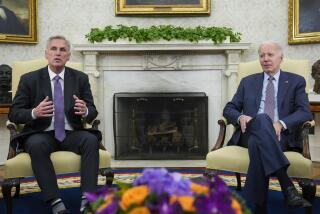Health bill has support lined up
- Share via
WASHINGTON — House Democrats on Thursday closed in on the votes they need to pass sweeping healthcare legislation, as party leaders introduced a 1,990-page bill designed to guarantee near-universal coverage for the first time in the nation’s history.
The legislation, which House Speaker Nancy Pelosi (D-San Francisco) officially unveiled in a ceremony outside the Capitol, represents a milestone for Democrats and advocacy groups.
After more than half a century of pushing to create a government healthcare safety net, Democrats are poised to bring a bill to the House floor next week. The full Senate will probably take up its version by the end of the year.
The House plan would cover an additional 36 million people by 2019, leaving only 4% of the nation without coverage, compared with the estimated 17% who do not have insurance now, according to a preliminary analysis by the nonpartisan Congressional Budget Office.
“Leaders of all political parties, starting over a century ago with President Theodore Roosevelt, have called and fought for healthcare and health insurance reform,” Pelosi said. “Today, we are about to deliver on the promise of making affordable, quality healthcare available for all Americans.”
Pelosi and her lieutenants have been working for months to find the 218 Democratic votes they need to get a bill through the House, negotiating a series of compromises that form the backbone of the legislation they introduced Thursday.
The revised bill swayed a number of wavering Democrats, convincing House leaders that they had enough support to move ahead.
“I feel very confident we will have the votes necessary,” said Rep. James E. Clyburn (D-S.C.), who as the party whip is responsible for counting votes.
Among those who now back the legislation is Rep. Earl Pomeroy (D-N.D.), a fierce critic of an earlier provision that would have created a government insurance plan tying payment rates for hospitals and other providers to Medicare.
“There’s been a lot of give and take,” said Pomeroy, expressing support for a change that would require the government plan to negotiate its rates with providers, much as commercial insurers do.
“In the end, we negotiated successfully to resolve the situation,” he said. “This bill represents a distinct improvement over the status quo.”
Similar compromises were made to win over other potential “no” votes -- including Rep. Gerald E. Connolly (D-Va.), who had been concerned that a surtax on wealthy taxpayers could have a huge effect on his suburban Washington district. The tax was scaled back in the version unveiled Thursday.
Senior Democrats are still trying to resolve several divisive issues, including provisions to prevent the use of federal funds for abortion services -- a priority for many socially conservative House Democrats.
Democratic leaders also face questions about the cost of the legislation, which by one measure exceeds the $900-billion benchmark set by President Obama for the first 10 years, even though the new spending is expected to be fully offset over the next decade with cuts and new revenue. The CBO has estimated that the bill would reduce the deficit by $104 billion over the next decade.
Few if any Republicans are expected to back the House bill or its counterpart in the Senate, as party leaders have continued to criticize the Democratic healthcare campaign as a “government takeover.”
“Over the last several months, the American people have spoken, and it’s pretty clear that our Democrat colleagues have not listened,” House Minority Leader John A. Boehner (R-Ohio) said Thursday. “Through the month of August and September, the American people let members of Congress from both sides of the aisle know that they wanted no part of a government-run healthcare plan.”
Democrats also face opposition from the insurance industry and from many business groups -- 10 of which wrote a letter to lawmakers Thursday saying that the legislation “falls short of the bipartisan goal of controlling costs and jeopardizes employer-sponsored coverage.”
Many business groups oppose provisions in the bill that require larger employers to provide a minimum set of benefits to their employees or pay a penalty. Businesses also have expressed concern that the bill does not do enough to control rising healthcare costs.
If the House approves the bill next week, it will have to be reconciled with whatever Senate Democrats can get through their chamber. Senate Majority Leader Harry Reid (D-Nev.) is working to rally his caucus behind a bill, a process that is expected to stretch into December.
Democrats underscored the sweep of the legislative journey Thursday by turning to Rep. John D. Dingell (D-Mich.), the longest-serving U.S. representative in history. Dingell presided over the House the day lawmakers voted in 1965 to create Medicare and Medicaid.
He brought the gavel he used that day to the West Front of the Capitol, where Pelosi announced the new bill. “It’s a good piece of wood that doesn’t wear out with one great event,” said Dingell, who has introduced a universal healthcare bill every congressional session since he came to Washington in 1955.
The current House bill would for the first time require almost all Americans to get health insurance or pay a penalty.
Americans who do not get coverage through work would have access to a new insurance exchange, where they could shop among plans offered by commercial insurers and the federal government.
Private insurers, who stand to gain millions of new customers, would no longer be able to deny coverage to sick people and would have to offer a basic set of benefits, including coverage for mental health services.
The government also would provide subsidies to help millions of low- and moderate-income earners buy coverage. And for the first time, all Americans making less than 150% of the federal poverty level would be eligible for Medicaid, the joint federal-state insurance program for the poor.
The Democratic bill also would provide relief to small businesses -- exempting most from the requirement to provide workers with benefits and allowing many to use the new insurance exchange.
As for senior citizens, the legislation could make prescriptions more affordable by closing the Medicare drug coverage gap and allowing the government to negotiate discounts -- a provision opposed by the pharmaceutical industry.
The tab for the House plan would top $1 trillion over the next decade, according to the CBO.
To offset that, the legislation relies on $135 billion in penalties on employers that do not provide coverage, as well as a series of cuts in Medicare payments to healthcare providers that lawmakers hope will make the system more efficient.
The biggest single source of funding is the new surtax on individuals who make more than $500,000 a year and couples who make more than $1 million. The Joint Committee on Taxation estimated that would generate more than $460 billion over the next decade.
The tax remains among the most controversial aspects of the legislation and a likely sticking point in future negotiations with the Senate.
Senate Democrats have rejected an income surtax, and are expected to rely instead on a tax on high-end, or “Cadillac,” insurance plans to offset the cost of their healthcare bill.
“The difference of opinion is rather strong,” said Rep. Charles B. Rangel (D-N.Y.), chairman of the tax-writing House Ways and Means Committee, acknowledging that House and Senate Democrats have a lot of work to do to resolve their conflicts.
“Everything necessarily has to be on the table,” he said. “This is going to be exciting.”
--
More to Read
Get the L.A. Times Politics newsletter
Deeply reported insights into legislation, politics and policy from Sacramento, Washington and beyond. In your inbox three times per week.
You may occasionally receive promotional content from the Los Angeles Times.












